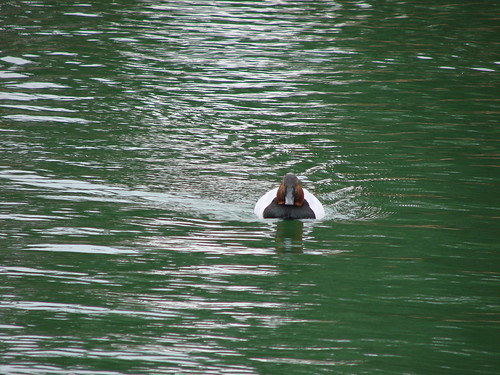tags: Canvasback, Aythya valisineria, birds, nature, Image of the Day
[Mystery bird] Canvasback, Aythya valisineria, photographed in southeastern Arizona in February [I will identify this bird for you tomorrow]
Image: Rick Wright [larger view].
Rick Wright, Managing Director of WINGS Birding Tours Worldwide, writes:
Steaming straight at us, this mystery bird is going to make it hard to apply our foolproof start-at-the-rear method. The head-on pose also puts paid to any attempt to identify it by picture-matching. This is one of those cases where a bird that is easy as can be in full field-guide profile, when seen badly or from an odd angle suddenly requires a deeper familiarity. Those who know this species to some extent will have identified the quiz bird right away; those who don't can look forward to spending some enjoyable time this winter really looking at waterfowl.
A vast variety of birds regularly swim, from pigeons to pigeon guillemots, from dippers to dabchicks. The oval body, large head, and square-tipped bill of our quiz bird identify it quickly enough as a duck, and the fact that the bird is patterned in large discrete blocks of color leads us to the diving ducks; dabbling ducks tend to be more intricately patterned. The quiz bird's general pattern of dark breast and head and pale sides points us in the direction of the pochards, diving ducks of the genus Aythya.
Once we've got that far, it's easy to let the bright white of this bird's back identify it as a male Canvasback. Does everything else fit? The sides of the head are burnt cinnamon, the crown and forehead blackish; on Redhead, the crown is the same, purer red as the rest of the head. The eye is red; it is yellow on drake scaup, Ring-necked and Tufted Ducks, and Redhead. The bill profile is not visible, of course, but we can see that the bill starts high on the head and is equally wide throughout its lengh; it is also all dark, another well-known character for Canvasback.
The photo shows a couple of additional features that are less widely known. Notice that the black breast in this view "floats," strikingly surrounded by the white of the remainder of the underparts; on all other pochards, the black extends much farther onto the sides of the breast, making them look essentially black in a head-on view. We can also just glimpse the fact that the border between the black and white -- vertical on other species -- "slants" on Canvasback.
Nearly all field guides point to the value of head shape in identifying pochards, but then illustrate only the profile. Each species also has a distinctive "cheek" shape. Canvasbacks are distinctively jowly from the rear or head-on, the mass of the head low down and droopy. This winter, try to get a sense of the cheek shape of the other Aythya species, too: it's always good to have something to talk about with strangers at cocktail parties.


canvasback
Ducks! Yay!
Yes, canvasback.
Any clues about where the photo was taken? It looked familiar, and a flick through my Collins guide suggests it might be a pochard. But that might not do if the photo wasn't taken in Europe.
Whatever it is, I do like the photo.
this is an american bird, but i do not know where precisely the picture was taken.
The photo was taken in southeast Arizona in February--a paradise for waterfowl watchers!
Clearly a canvasback, even though the picture manages to hide my favorite fieldmark, the ski-jump nose.
This is aqn adul male Canvasback.
none other than a drake Canvasback